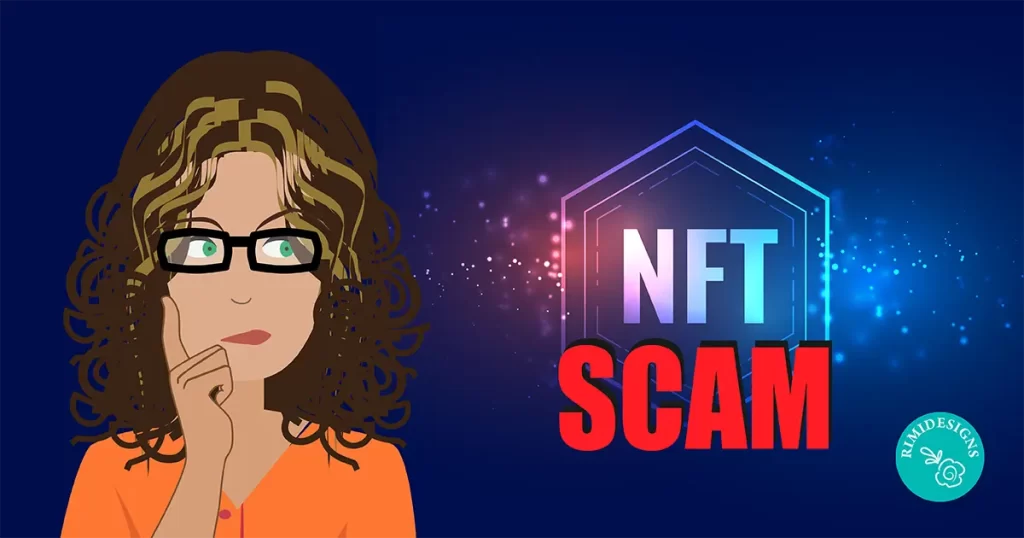
How to Avoid NFT Scams: Protect Your Digital Assets
NFTs (non-fungible tokens) have exploded in popularity, opening up new avenues for artists, collectors and investors alike. However, with this surge in interest, scammers have become more sophisticated, targeting unsuspecting buyers and creators.
In this post, I’ll explore common NFT scams and provide tips on how to avoid falling victim to them.
What are NFTs?
NFTs are unique digital assets stored on a blockchain, representing ownership of a specific item, artwork or piece of content. Unlike cryptocurrencies like Bitcoin, each NFT is one-of-a-kind and can’t be replicated. They have gained significant attention in the art world, gaming and even entertainment, creating new ways to buy, sell and trade digital goods.
But as the NFT space grows, so does the number of scams. Let’s break down some of the most common scams and how you can protect yourself.
Common NFT scams
1. Phishing scams
Phishing is one of the oldest tricks in the book, but it’s still incredibly effective in the NFT world. Scammers send fake emails or social media messages pretending to be a legitimate NFT marketplace, asking you to click on a link to verify your account or make a purchase. These links lead to fake websites designed to steal your personal information or wallet credentials.
How to avoid it
- Always double-check the website URL before entering sensitive information.
- Avoid clicking on links from unsolicited emails or messages.
- Use a password manager to ensure you’re accessing the correct website.
2. Fake NFT listings
Some scammers list fake NFTs for sale on various marketplaces, claiming to offer valuable, one-of-a-kind items. These NFTs may be stolen art or, in some cases, not even minted on the blockchain. Once someone purchases the NFT, the scammer disappears with the funds, leaving the buyer with nothing.
How to avoid it
- Research the NFT’s creator before making a purchase. Check their social media profiles and any previous work they’ve done.
- Verify the NFT’s authenticity by checking the token’s metadata on the blockchain.
- Stick to well-known, reputable NFT marketplaces like OpenSea, Rarible or Foundation.
3. Rug pulls
Rug pulls occur when a project or collection promises huge returns but disappears after investors have purchased in. In the NFT world, this usually happens with new projects that claim to be launching exclusive art collections. Once buyers purchase NFTs, the project creators vanish and the value of the NFTs crashes.
How to avoid it
- Investigate the team behind the project. Are they doxxed (publicly identifiable)? Do they have a history in the NFT space or a reputation for delivering successful projects?
- Be cautious of “too good to be true” offers. If a collection promises massive returns or overstates the rarity of its assets, it may be a red flag.
- Stick to well-established projects and avoid high-risk, unproven ventures.
4. Fake airdrops
An airdrop is a method of distributing free NFTs to users, often as part of a promotion. However, scammers sometimes send fake airdrops to unsuspecting wallets, offering a “free” NFT that asks for sensitive information like private keys or wallet access. Once you provide this information, they can drain your wallet.
How to avoid it
- Never provide your private keys or seed phrases to anyone, regardless of the offer.
- Be cautious when receiving unexpected airdrops. Verify the legitimacy of the offer through trusted channels before accepting anything.
5. Smart contract exploits
Smart contracts are self-executing contracts with the terms directly written into code. However, some scammers take advantage of flaws in smart contract code to steal NFTs or funds from users. If you’re interacting with an NFT project, it’s essential to ensure the smart contract is secure.
How to avoid it
- Only interact with projects that have been audited by reputable third parties.
- Be cautious of projects with complex or poorly written smart contract code.
- Check for transparency from the development team regarding the contract’s security measures.
Tips for protecting your NFTs
Use a secure wallet
Always store your NFTs in a secure wallet, preferably a hardware wallet, for added protection. Never store valuable NFTs in exchange wallets.Enable Two-Factor Authentication (2FA)
For any marketplace or platform you use, enable 2FA to add an extra layer of security to your accounts.Stay educated
The NFT space evolves quickly, so keep yourself informed about the latest scams, security best practices and emerging threats. Follow reputable sources and communities to stay updated.Backup your wallet information
Make sure to back up your wallet’s seed phrase in a secure location, but never share it with anyone. If someone asks for your seed phrase, it’s almost certainly a scam.Research before you buy
Always perform due diligence before making a purchase. Check the authenticity of the artist, the project and the NFT itself. A little extra research can go a long way in avoiding scams.
Conclusion
While NFTs can offer exciting opportunities for creators and collectors, the space is not without its risks. By understanding the common scams and taking steps to protect yourself, you can navigate the world of NFTs with confidence. Always stay vigilant and remember that if something seems too good to be true, it probably is.
By following these tips and staying aware of potential threats, you can enjoy the world of NFTs while keeping your digital assets safe and secure.
Disclaimer: This article is for informational purposes only and does not constitute financial or legal advice. Always do your research and consult with professionals before making any investment.



